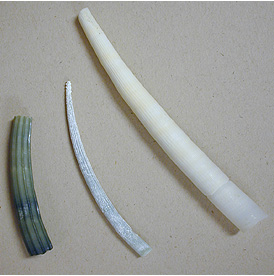
Scaphopod or "Tusk Shells." photo © Ralph Body, from Preface to Class of Scaphopoda.
| Scaphopoda | ||
| Mollusca | Scaphopoda |
Conchifera
└─► |
|||
None |
Mollusca |
|
Abbreviated Dendrogram
Mollusca
├─Aculifera
└─Conchifera
╞═Tryblidiida (Monoplacophora)
│ └─Cephalopoda
╘═Helcionelloida
╞═Rostroconchia
│ └─Scaphopoda
├─Bivalvia
└─Gastropoda
|
Contents
|
Taxa on This Page
 |
|
Scaphopod or "Tusk Shells." photo © Ralph Body, from Preface to Class of Scaphopoda. |
Scaphopods are a small group of mostly small, infaunal or semi-infaunal, marine mollusks. There are an estimated 500 extant species known. They are fairly common in deeper water environments (being found at depths from 6 to 1,830 meters), and only a few species live nearshore. Because of this they are little known to the average person; and, unlike gastropods and bivalves, their shells are rarely washed up on beaches.
The scaphopod shell is quite unlike the usual molluscan form. It is a slender tapering and usually gently curved tube, not unlike a miniature elephant tusk, hence the common name "tusk shells". It is open at both ends, the large end of the shell being the anterior. The exterior has finely spaced growth lines and usually some type of longitudinal ornamentation or ribs. In color it is usually white or yellowish, although one species is a brilliant jade green. Barnes (1980: 434).
Most scaphopods are small; the largest living forms being usually no longer than 8cm, with the maximum diameter of about 6 mm; and most species being much smaller than this (often only about 4 or 5 mm.). The largest living species, Dentalium vernedei, found off the coast of Japan, has a maximum length of 15cm. A fossil species of the genus is known to have attained twice that length, with a maximum diameter of well over 3 cm
A protrusible burrowing conical foot extends from the anterior end; the mantle cavity is large and extends along the ventral side of the animal to the smaller, posterior opening, through which respiratory currents pass. There are no gills, so respiration is accomplished by direct exchange with mantle tissue. The head is poorly-developed. The animal feeds on microscopic organisms, mostly foraminifers and organic detritus. This food is passed to the mouth via tentacles (called captacula) and tentacular cilia, and is processed by the radula.
Scaphopoda first appear in the Ordovician see also Reynolds for references for the Ordovician date) or the Devonian Engeser & Riedel) or even the Mississippian, depending on one's interpretation of the earliest forms. Yochelson (1978). They are fairly rare in the fossil record, except for occasional concentrations in Cenozoic deposits.
At one time Scaphopods were believed to be closely related to bivalves, as their early development very closely parallels that of marine bivalves (in the course of development the shell is originally bivalve). It was suggested that both groups descended from extinct bivalved mollusks called rostroconches. Runnegar & Pojeta (1974). There is now strong evidence (Steiner & Dreyer, 2002) that the Bivalves diverged from the main evolutionary sequence of the mollusks much earlier than the Scaphopods, which are actually much more closely related to Cephalopods. According to one hypothesis, both Cephalopods and Scaphopods evolved from a tiny, semi-infaunal helcionellid ancestor, probably some time in the Furongian. However, Engeser and Riedel 1997 argue for an origin from Devonian conocardioid rostroconches, as the early scaphopod shell resembles the adult conocardid shell. If this hypothesis is correct, then the Scaphopods are by far the last Molluscan class to emerge.
The Class Scaphopoda is divided into two orders, the Dentaliida and the Gadilida or Siphonodentalioida). The latter is distinguished by the constriction of the anterior aperture and the shape of the central tooth of the radula (Reynolds. The Dentaliida may or may not be paraphyletic, as the appear much earlier, so it is possible the Gadilida (which first appeared in the fossil record in the Permian) evolved from them. However, the systematics of the group are still poorly worked out.
Reference(s): Parker 1982
Range: Ordovician or Carboniferous to Recent
Phylogeny: Paraphyletic Helcionelloida : Gastropoda + (Bivalvia + (Rostroconchia paraphyletic Rostroconchia : Conocardiida + (Ribeirioida + *))
Comments: about 500 extant species, elongate body in a tubular tapered shell open at each end. The mantle cavity is large and extends along the whole ventral surface. No gills. The head of the Tusk Shell has no eyes, but it has paired clusters of clubbed contractile tentacles, called capitula. The head and cylindrical foot can emerge from the larger end of the tapered shell. The sexes are separate, and fertilization is external. All species are are benthic and marine Jack R. Holt. Evolved from rostroconchian ancestors. Previously grouped, on morphological and neontological evidence, with either the Bivalvia (as subphylum Diasoma) or the Cephalopda;current molecular phylogeny tends to favour a scaphopod-gastropod-bivalve clade, which supports the scenario of all three groups evoving from early Cambrian infaunal helcionelloid ancestors , MAK120614.
Links: The Scaphopod Page by Patrick D. Reynolds - a very informative introduction to recent and fossil members of the group. Introduction to the Scaphopoda - a good introduction to the group (UCMP website); Fossil Scaphopoda - information on fossil Scaphopoda, and the origin of the group; Mollusca - Class Scaphopoda - short intro; Scaphopoda - intro
page uploaded 2 December 2002, page by M. Alan Kazlev, reformatted and moved ATW060210, checked ATW050731, last revised MAK120614 Creative Commons Attribution